ASRock Rack C2750D4I Review: A Storage Motherboard with Management
by Ian Cutress on April 29, 2014 9:00 AM EST- Posted in
- Motherboards
- Storage
- Atom
- ASRock
- Silvermont
- Enterprise
- server
- Avoton
ASRock C2750D4I BIOS
Consumer motherboards hide a lot of options that do not make sense to regular users. There is also the concept of that while a setting exists, anything other than the manufacturers recommended setting is ill-advised. In the server space this does not happen. Almost everything is available to the server administrator, whether he understands it or not. As a result, a motherboard BIOS can be almost all gobbledegook.
As mentioned in previous server motherboard reviews, while a company might release both server and channel products, internally these two teams act almost wholly independently. There is little crossover to speak of, and only when the firm’s brand is the topic will they meet. This might come across as an over-exaggeration, but it is almost two different companies working in the same building, with different engineering staff, different BIOS teams and different FAEs. As a result, there can often be a lack of consistency between platforms. The prime example is usually the BIOS, where the server team have not adopted the graphical BIOS layouts of the channel-facing business. We see this with the C2750D4I, where ASRock Rack (the server department in ASRock) is using an older American Megatrends layout.
The first screen of the BIOS shows the Motherboard name and BIOS version, the CPU installed, its speed, the total memory and how that memory is distributed. In a full graphical BIOS I would expect other data such as the CPU temperature, CPU voltage and fan speeds.
The advanced menu houses all the configuration elements of the system, and as I mentioned above this is where a mass of options can confuse. Aside from the normal features a channel motherboard user is used to (USB configuration, SATA configuration), we can adjust things like ‘Root Ports De-emphasis’:
Navigating to the North Bridge configuration gives options to adjust memory speed, memory voltage and subtimings:
There is no XMP setting, but the system does offer ‘Auto’ for the subtimings so if one is changed the user should not need to compensate with the others. Ideally I would like the BIOS to detect the default setting for the DRAM installed and show this value next to the timing configuration options.
By default, the C2750D4I has all sleep states disabled in the BIOS:
Thus in order to activate S3/S4/S5 in the OS, this needs to be enabled.
To answer a specific point raised in our last server motherboard review, the C2740D4I does have an option to enable Above 4G Decoding. This is set to disabled by default.
Because this BIOS is a UEFI, the fast boot options for Windows 8 users are in the CSM menu under the Advanced tab:
The server management software has access to all the sensors on the motherboard, and so does the BIOS in the H/W Monitor tab. Here are also the fan controls, offering users a SmartFan option or Level 1-9 that gives increasing fan speed gradients. By default all fans are set to 100% which is ideal for a server environment but perhaps not inside a case.
The BIOS also offers basic event logs, although for more detail the IPMI should be used. One feature missing from the BIOS is a boot override function, although users can rearrange the boot order.
Another feature missing from the BIOS is the ability to update through the BIOS itself. Users will either have to install an OS and update, or create a DOS-bootable USB stick and run the commands through that.
ASRock C2750D4I Software
Like many of our server motherboard reviews, the C2750D4I comes up a little short compared to what channel consumers are used to. This is in part due to the lack of cross-collaboration between server and channel (I would hazard a guess that parts of the channel software package can be bought over), but also the nature of server usage scenarios. For virtualization, motherboard software is not needed, and for headless/command-line boxes there might not be any need for OS interaction (especially not Windows). Perhaps in the workstation use scenario it would make more sense, or if a user was planning to use the C2750 as a NAS/HTPC combination.
As a result our software is limited to the Marvell RAID utility, due to the use of Marvell controllers, and the management platform.
Marvell Storage Utility
We have come across this utility on the consumer motherboard side when Marvell controllers have been used. During parts of Z68 and Z77 these were favored either due to cost or functionality variation. The utility allows the user to build RAID 0/1 devices using the Marvell controllers, as well as look at adapter specifications:
Management Interface
Using the Aspeed AST2300 via the network interface, ASRock has a slightly skinned version of the American Megatrends IPMI interface (with iKVM support). After login the user has an initial management screen that gives all the sensor readings, a breakdown of types of event log and an option to access the Java based remote control platform.
Unfortunately this screen had issues with browser resizing, and thus only a full screen gave the details in a single screenshot:
Unfortunately the Java applet does not have the appropriate security clearance for the latest update of Java, and users will have to enable unsecure apps in the options in order to get it to work in full access mode. The alert screen that popped up while we were testing suggested that in future updates of Java this sort of applet will be blocked completely.
We selected a few options in this interface to examine, including the sensor readings log:
When one of the sensors hits the non-critical, critical or non-recoverable value (either high or low), this log will collate those entries to show the frequency at which they occur. Users can navigate to the event log itself to determine at what time these messages occurred.
One of the things I like about a server management tool is the ability to remote shutdown or turn on a system. The C2750D4I also has this in the Remote Control section.
The interface also offers a video recording tool that will activate if one of the sensors is triggered. This tool will record the visual output of the display and save it to the device in the specified directory so users can debug what caused the sensor issue.
The interface also keeps a list of running services through the BMC:


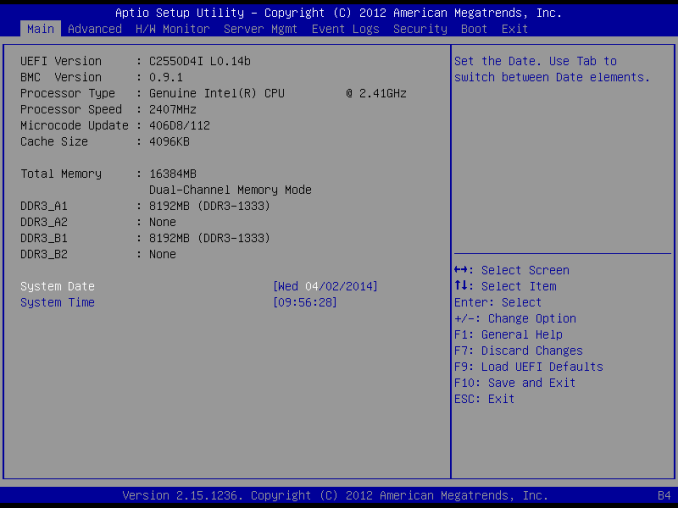

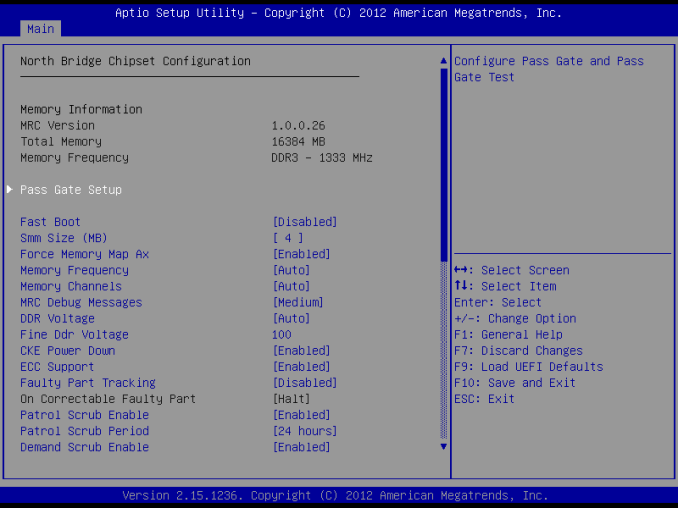


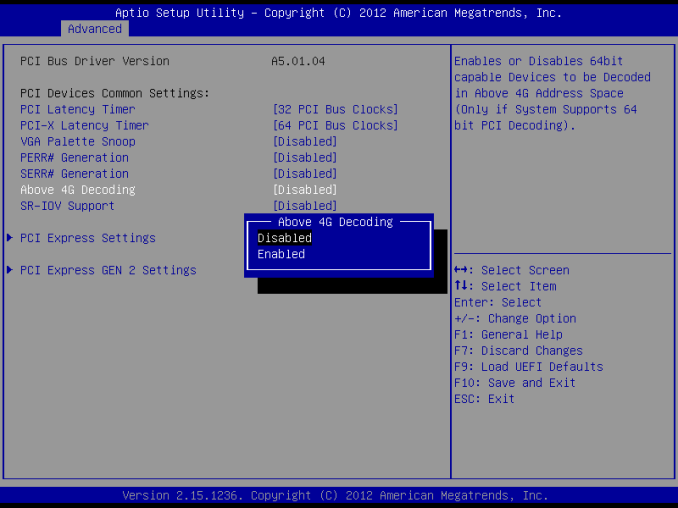
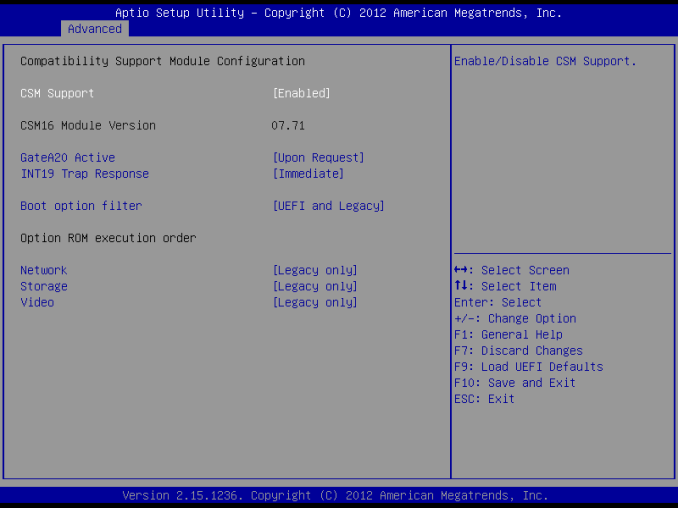






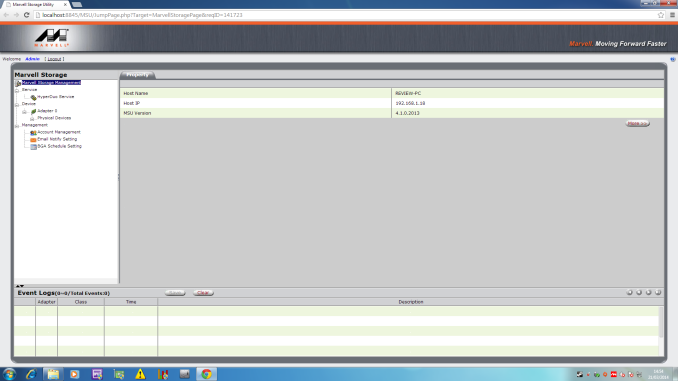
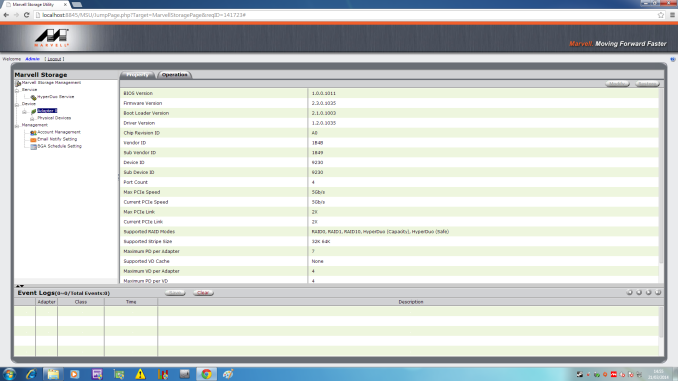
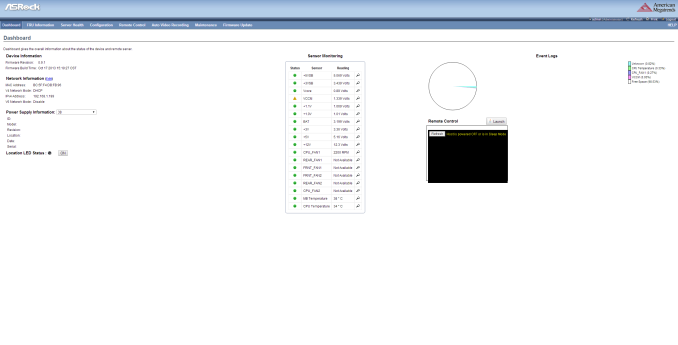
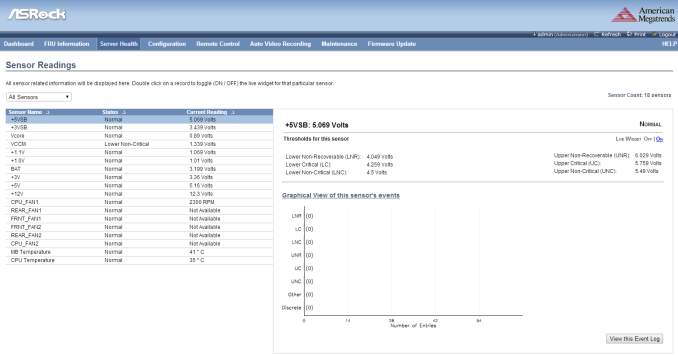
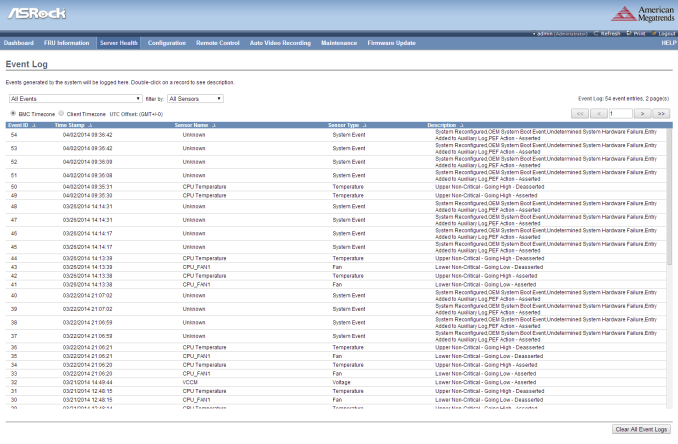
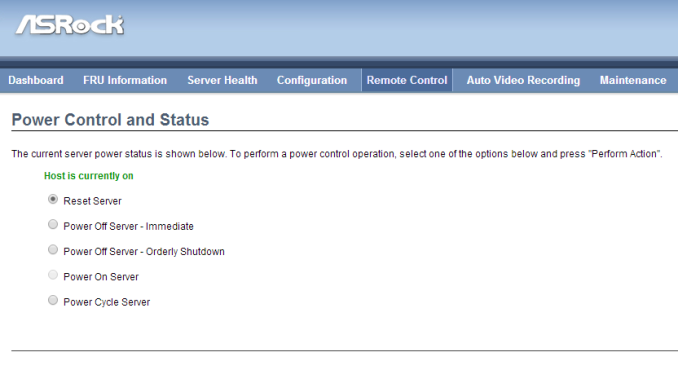
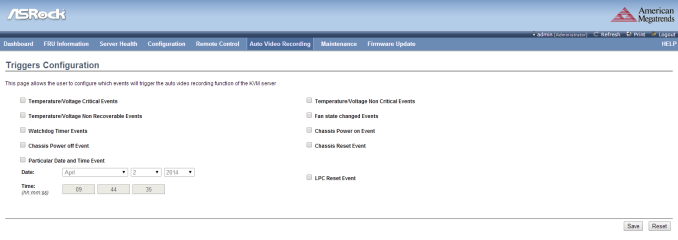















85 Comments
View All Comments
chekk - Tuesday, April 29, 2014 - link
Yes, for that price and target market, they should have gone with an LSI chip. You don't see Supermicro or Tyan boards in that price range using Marvell.cen - Tuesday, April 29, 2014 - link
I know it was said that the actual storage review is coming in the future but I think this article is a complete waste of time. You should simply let the storage review happen and not bother with this at all. More than half of the benchmarks are useless, the only ones of value might be encryption and compression.What we actually want to see is FreeNAS thrown in there with a 16TB ZFS zpool and some IO benchmarks. :)
Calista - Tuesday, April 29, 2014 - link
Could be perfect for anyone wishing to build a tiny box for virtualization, a task in which many a NIC, plenty of RAM and a multicore processor is most helpful.RandomUsername3245 - Tuesday, April 29, 2014 - link
I've wondered how one of these Avoton boards would compare to a Supermicro C2xx + Pentum G3430 (which supports ECC). This is the cheaper option if you don't need lots of ports, but once you add $100 for a sata card from Ebay, these options are similarly priced.Calista - Tuesday, April 29, 2014 - link
Could you please measure power consumption without the 770 as well? I have a HP Elite 8200 with a quad i5, SSD + 2.5" HDD, 32 GB RAM and an extra NIC as a makeshift box for ESXi and with 6-8 virtual machines running it draw less than 30 watt. It would be interesting to know how low this machine could go since any machine running 24/7 will add substantially to the power bill.Guspaz - Tuesday, April 29, 2014 - link
If I was using this in my home file server, I'd make a few changes to the board. The number of SATA ports is fine, because even though I've got 18 drives in mine, that PCIe slot lets you put in a SAS/SATA controller to get the total up as high as needed (16 port cards aren't hard to find, higher is available).However, I'd change a few things:
1) Replace the CPU. Home file servers can often be bottlenecked by individual CPU core performance, because not all filesystem operations on ZFS are multithreaded (although it's far better these days). For the ~25W TDP, I would much rather have a Haswell part, even if it meant fewer cores. For that TDP, you could get a ~3GHz dual-core part, or a ~2GHz quad-core part. Either of those would be better suited.
2) Add digital video output. HDMI, DVI, DisplayPort, any of them. I'm not suggesting using this thing for HTPC use, but many monitors these days are digital-only, and nothing is more annoying than trying to diagnose problems with a headless system when your motherboard is VGA-only and all you have is digital-only monitors.
3) Drop two of the RAM slots, and use them for another PCIe slot. Four slots is excessive for anything but enterprise use. Two slots cheaply gets you 16GB of RAM, or 32GB if you're desperate, either of which is more than enough for a home file server. A second PCIe slot, on the other hand, could enable a variety of other options, be they multiple SAS/SATA cards, a discrete video card if you really do want to use the thing as an HTPC, a video capture card (this board in that Silverstone case would probably make a decent HD-SDI recording box), etc.
4) More USB ports, prefereably 3.0. If extra space is needed for the ports, ditch one of the three GigE ports; two is plenty.
5) An mSATA slot for a boot drive could be useful, although it would probably increase board complexity by requiring some of the board components to move to the rear.
stoatwblr - Thursday, May 1, 2014 - link
"Two slots cheaply gets you 16GB of RAM, or 32GB if you're desperate"My ZFS media rig has 19 drives (21 including the ZIL and l2arc), plus boot media and at 36Tb it _needs_ 32Gb of ram to work efficiently. It kept bottlenecking at 16Gb. The next round of storage will push well past the 32Gb requirement.
+1 on the video output, +1 on usb3 - but I don't think it needs more ports. That's not a good fit for the target, which is a storage controller. Ditto on the mSATA.
If you need fewer cores there's a quad-core version which is cheaper.
I'd prefer that they placed a lsi sas controller onboard and dumped the sata ports for minisas (an expander cable is cheap, tidy and positively locks into place to ensure no problems.) The downside is that a decent sas controller would add at least $100 and a port multiplexer as much again.
If I was designing, I'd think about 10Gb copper, but that adds 15W to the power consumption and $150 to the price.
This thing is expensive for prosumers and limited for enterprise, but compromises are always like that. Supermicro's version has similar issues and the fact that they don't use minisas makes me think that perhaps Intel have placed restrictions on what can be used.
bernstein - Thursday, May 1, 2014 - link
well my zfs rig has 20 2.5" 2tb sata hdds (2x 16tb raidz2). no ZIL. no L2ARC.runs on a single 8GB ecc ddr2 dimm on a sandy bridge i3-2100T.
as a home fileserver this system rocks. it might be ram "bottlenecked" for high i/o tasks, but all i can see is that it performs at least as well as a single USB3 hdd... and it outperforms any consumer nas.
Daniel Egger - Tuesday, April 29, 2014 - link
For a NAS or SAN build this seriously lacks 10GbE and USB 3 ports. All in all this board seems like a pretty strange amalgamation of random features, as there're better choices for about any possible use case around.Gunbuster - Tuesday, April 29, 2014 - link
14000 RPM Delta fans? No Thanks!I would have called it the AssRack. Sorry I couldn't resist!